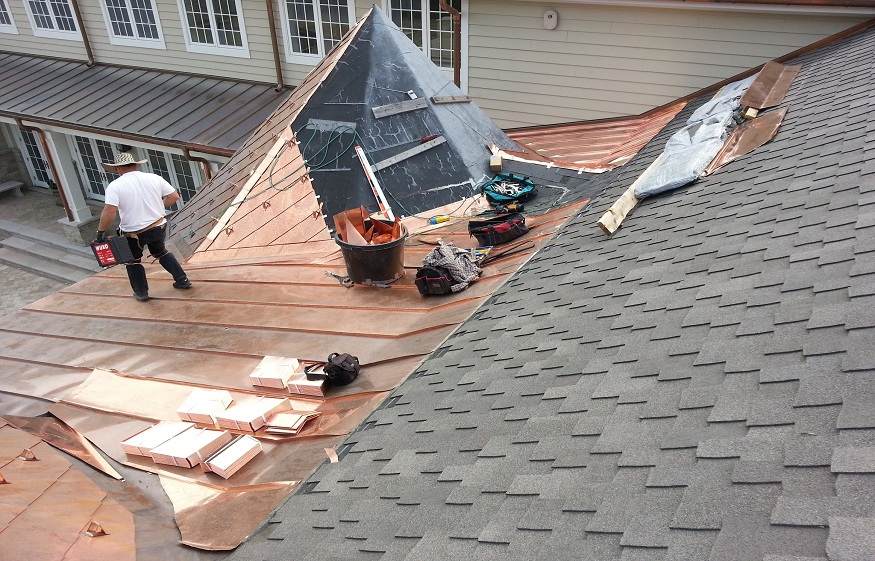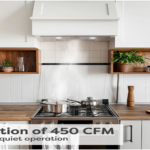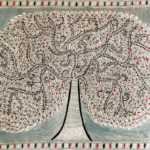 Key Takeaways:
Key Takeaways:
- Copper roofing combines aesthetic appeal with durability, lasting over 50 years and often more with proper maintenance.
- It is resistant to corrosion, fire, and pests, providing lower long-term repair costs.
- Copper is environmentally friendly, being 100% recyclable, and develops a protective patina over time.
- The initial investment for copper roofing is higher than alternatives, but reduced maintenance and improved energy efficiency can make it a cost-effective long-term option.
- Before installation, ensure the roof structure can support copper’s weight and check the integrity of the roof decking.
- Ideally, schedule installation during dry seasons with mild temperatures to ensure better working conditions.
- Use essential tools, such as metal brakes, snips, and safety gear, to facilitate a smooth installation process.
- Precise measuring, cutting, and joining techniques are critical for a successful copper roof installation.
- Install flashing before the copper panels to prevent water penetration, especially in vulnerable areas.
- Regular cleaning and maintenance will preserve the roof’s appearance and performance; avoid harsh chemicals that can damage the surface.
- Embrace the natural patina process of copper as a sign of craftsmanship and beauty rather than a deterioration.
- Address common issues like leaks or galvanic corrosion promptly to extend your copper roof’s lifespan.
Understanding Copper: A Beautiful Yet Durable Choice for Your Roof
Why Choose Copper? The Aesthetic and Functional Benefits
While a copper roof provides a grand exterior view, it encompasses the enjoyment of resilience: durability and distinctive flair. Its golden metallic warmth goes well with anything from modern builds to historic homes. One of the biggest advantages of copper is that it is very durable. Copper, unlike other roofing materials, can easily last 50 years and properly maintained specimens have stayed intact for over 100 years. Copper is also resistant to corrosion, fires, and pests, which will lead to lower repair costs over the years.
A third good reason for selecting copper is its eco-friendly characteristics. Copper is 100% recyclable, and the energy needed to recycle copper is only a small percentage of the energy necessary to produce it originally. Copper is a timeless metal that exudes elegance, and when homeowners choose it, they not only increase their property value but also guarantee environmental friendliness. Also, copper oxidizes, developing a natural patina as corrosion forms over time that serves to improve aesthetics and add additional protection to the underlining copper.
The History of Copper Roofing: From Ancient Temples to Modern Homes
In ancient civilizations, copper was used for roofs and architectural detailing, as seen in notable buildings such as the Venetian churches and even the roof of the Pantheon in Rome. Copper’s use throughout the ages has cemented it as an emblem of opulence and longevity. The use of it in famous buildings like the dome of the United States Capitol and Notre Dame Cathedral only adds to its historical impact.
Fast forward to modern day, copper is still regarded a top-of-the-line roofing option among builders and architects alike. It is sophisticated and is one of the common types of roofing material used in modern residential architecture, as well as for decorative elements such as with Gutters, downspouts, and standing seam panels. So, the reason for choosing copper roofing is it also connects homeowners with a tradition of quality, elegance, and time-honored beauty.
Weighing Costs: Is Investing in Copper Worth It?
When looking at roofing materials, the cost is usually a big consideration. Copper roofing is often more expensive to install than alternatives due to the high cost of the raw material itself. Factors such as gauge thickness, style, complexity of the installation, and the provider’s regional labor costs affect price. Typically, copper roofing installation runs about $15 to $30/sq. ft. While it may have a steep initial cost, copper is a wise investment for many reasons.
Increased durability means lower maintenance cost during its life span and better energy efficiency. One of the more attractive features of copper is that homes tend to be cooler in summers because of copper’s reflective qualities, which could reduce air-conditioning costs. Due to its durability, the lifetime cost of ownership of copper roofing is often lower than that of inferior materials, which might need to be replaced or repaired more often. Therefore, copper roofing is not just an investment; it is an investment in the aesthetics and strength of your home for years to come.
Preparing for Installation: Key Considerations Before You Begin
Evaluating Your Roof Structure: Is It Ready for Copper?
Before we get into the installation process, the first thing you need to determine is if your roof structure is ready for copper. Integrity of the roof deck should be good and have enough strength to carry the extra weight of copper panels that could be much heavier than conventional roofing material. It’s important to look for sagging, leaks or other signs of wear and damage. If the roof decking is in bad condition, then repairing or replacing that becomes a priority before fastening copper to it.
Also take a look at the pitch of your roof. Copper roofing needs enough slope for effective water runoff; standing water can contribute to premature degradation. Another very important factor here is the number of existing roofing layers. If your home already has several layers of roofing materials, a full tear-off may be required prior to installing copper. In general, proper preparation and inspection for copper roofing ensure a successful and permanent installation.
Choosing the Right Time of Year for Installation: Timing Matters!
The season of copper roof installation is an important part of improving the project efficiency without compromising on quality. Weather is especially an important factor; hence, it is best to plan for installation during the dry season and mild temperatures. The windiest time of year is spring and early fall, which is often when such projects are undertaken, as there is a smaller chance of rain and better working conditions. Extreme temperature or cold poses a set of challenges too, creating issues with adhesives, sealants and how copper materials should be handled.
You should also check the availability of roofing contractors in your area. Scheduling your installation during off-peak seasons can often lead to lower prices and greater flexibility when it comes to time frames with contractors. Not just the climate is going to influence the installation process, but your copper is longevity and performance. Right timing and proper planning are key to a successful installation process.
Essential Tools and Materials: Equip Yourself for Success
Having the correct tools and materials at hand prior to starting the installation will minimize setbacks and improve your efficiency. The main materials needed to install copper roofing are copper sheets or panels, underlayment, such as felt or synthetic, metal-specific nails, and points or clips to secure seams. Safety first: A good pair of gloves, goggles and kneepads are must-haves — a safety culture is important when you’re going through this process.
Acquire basic equipment such as a metal brake for bending panels, a metal snip for cutting, a drill for fastening parts, and hammer for metalwork. Chalk line and measuring tape — You need these to create an accurate layout. Also, try to have a partner available, copper roofs can be heavy, and having an extra set of hands helps make installation easier. Having the proper tools and materials prepared beforehand lays the foundation for a successful, efficient copper roofing task.
Step-by-Step Installation Process: Building Your Copper Roof with Care
Measuring and Cutting: Precision in Every Angle
The actual installation of a copper roof starts with detailed measuring and cutting. A wrong measurement of your roof dimensions could lead to the wastage of materials and cost, so it is important to take an accurate measurement of your roof’s dimensions. Start by measuring the length and width of each section of the roof, including dormers or slope.
Once you have exactly where everything is, layout the copper panels in a uniform pattern, depending on the preferences of either aesthetics or architectural design. Use tin snips or a metal shear to cut sheets of copper. Always go with the grain of the metal to prevent bending or kinking. Keep in mind, we are looking to get seamless panels that fit well in place but maintain structural integrity and visual appeal.
Techniques for Seamless Joining: Tips for a Polished Finish
That has to do with how you join your copper panels together. A standing seam installation is an effective method for that, where the edges of the panels are bent upward to create vertical seams. This approach ensures that water runs effectively off and reduces the risk of leakage. Soldering to bond individual panels, water resistant seams.
Copper rivets or screws specifically designed for metal also are great techniques; they add extra fastening without compromising the integrity of the material. Try to use overlapping seams so that in the case of very heavy rain, water runs away, minimizing the likelihood of leaks. Standardisation of joining methods leads into the functional usefulness of stage 2 off roof with the aesthetics and visual quality of the completed roof as seen in this example.
Flashing and Detailing: Protecting Your Investment from the Elements
Flashing, spanning these seams, is the small component of the copper roofing installation process that helps align and seal the most vulnerable areas of the roof to water penetration, such as valleys, chimneys, and roof edges. Before assigning your copper panels, it is pivotal to introduce glimmering. Use fabricated copper flashings soldered at joints for the greatest assurance that no water will find its way into critical areas.
Spend time detailing your copper roofing edges — decorative accents will greatly enhance the overall aesthetic. Custom copper gutters can be installed to channel rain and snowmelt away from the seams. These details bring not only visual finishing but also strengthens the roof against a potential storm.
Maintenance and Longevity: Preserving the Beauty of Your Copper Roof
Cleaning Tips: How to Keep Your Roof Shining Bright
Maintaining a copper roof involves infrequent but specific cleaning routines that preserve its shine and integrity. Regular inspections for debris, moss, and leaves are necessary, as they can trap moisture and lead to accelerated corrosion. Utilize a soft-bristled brush or leaf blower to safely remove debris without damaging the copper surface.
For periodic deep cleaning, a mixture of mild soap and water with a soft sponge can effectively remove oxidation and grime. Avoid harsh chemicals or abrasive sponges, as they can cause scratches and diminish the roof’s finish. With minimal effort, you can keep your copper roof looking magnificent while ensuring it continues to perform optimally for many years.
Understanding the Patina Process: Embrace the Change
One of the most enchanting attributes of copper is its patina process, where the roof gradually changes from a bright copper hue to a rich greenish-blue over time, depending on environmental conditions. This transition, which occurs over several years, is caused by oxidation and creates a protective layer that further preserves the copper beneath it. Rather than seeing this transformation as a potential downfall, homeowners should embrace it as part of the charm and character of their copper roof.
Interestingly, the patina process is influenced by factors such as humidity, air quality, and geographical location. For instance, coastal areas may see a faster patina development due to saline conditions. Understanding and appreciating this process can enrich a homeowner’s experience, ensuring they recognize that the evolving color is not merely an alteration but a demonstration of quality craftsmanship and natural beauty.
Common Issues and Solutions: Troubleshooting Your Copper Roof
Although copper roofing is renowned for its durability, it can still face some common challenges that need addressing proactively. For instance, improper installation can lead to issues such as leaks, inconsistent patina formation, or premature corrosion. If you discover leaks, inspecting seams and joints is the first step; applying additional solder or sealant may remedy the situation.
Another frequent issue is dissimilar metals contacting copper, which can cause galvanic corrosion. Using compatible metals and ensuring proper isolation techniques can mitigate this problem. Additionally, copper roofs in areas with high moss growth may require periodic cleaning to prevent buildup, which can trap moisture and lead to accelerated deterioration.
Having a solid maintenance plan in place and addressing these challenges swiftly will ultimately extend the life of your copper roof, ensuring that it remains a beautiful, protective investment for generations.






Leave a Reply
You must be logged in to post a comment.